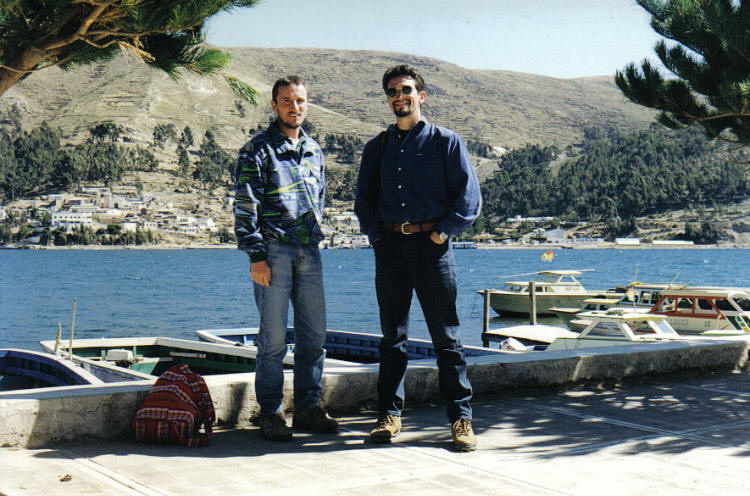COPACABANA
LA PAZ
LA PAZ
LA PAZ
VERSO TIHUANACO: LAJA
TIAHUANACO
TIHUANACO
TIHUANACO
TIHUANACO
LA CORDILLERA REAL
As soon as we crossed the border we stopped for lunch in the Copacabana Village on the peninsula that splits lake Titicaca in its southern and northern parts. After the lunch we went on and we crossed the strait dividing the Copacabana peninsula from the bolivian shore. While we humans we crossed the lake on a motor boat, the bus was put on a big raft and took to the opposite shore, making us worried because of the very strong stream and the bad conditions of the raft. However everything went right and after a while we went on again to La Paz.
After more than a hour driving on the road through the bolivian highland (over 4000 mt a.s.l.) we began to see many crumbled houses that seemed to introduce the outskirts of La Paz that we expected to be similar to Lima, with endless and crumbling suburbs. But after a few kilometers the bus suddenly turned on the left and below us a huge crater appeared with the Illimani as background, and on the bottom of the crater, 500 meters below, we saw La Paz buildings. It was an exciting view: we were then told that the best suburbs here are those lying lower because they are better sheltered from the wind of the highland.
We arrived at the hotel in late afternoon. It was a 4 stars hotel (Hotel Libertador) where we were offered a mate de coca as a welcome. Mate de coca is the national drink and it is very useful at high altitudes.
The center of La Paz, the lowest area where we stayed in hotel, is quite new, with big buildings around the boulevard that comes from the top of the crater. Just a little above there is the old part of this city that was a surprise for us: a city in the middle of a crater dominated by Illimani, a giant o 6600 meters, which is a very pleasant place. It’s a bit hard to walk around because of ups and downs, but it is definitly worth a visit.
La mattina dopo siamo partiti con il minibus alla volta di Tihuanaco: la giornata era bellissima. A circa 40 chilometri dall'orlo del cratere ci siamo fermati presso questa chiesa che è il luogo originale dove sarebbe dovuta sorgere La Paz. Qui infatti il 20 ottobre del 1548 Alonso de Mendoza, su ordine del vicerè di Spagna, fondò la "Ciudad de Nuestra Senora de La Paz" per commemorare la fine della guerra civile con il Perù. Sennonchè in breve si accorsero che lì faceva troppo freddo e quindi già l'anno successivo la città si trasferì nella valle dove si trova oggi. A Laja è rimasta solo questa chiesa...
Dopo un paio d'ore siamo arrivati a Tiahuanaco, il più importante sito archeologico della Bolivia, che è stato un centro cerimoniale della civiltà preincaica Tiahuanaco, intorno al 600 avanti Cristo. Il sito è piuttosto grande ed è veramente interessante. Numerosi siti internet sono in grado di fornire molte informazioni sul luogo: in particolare http://www.crystalinks.com/tiahuanaco.html, che è in inglese ma molto dettagliato.
Appena arrivati ci siamo resi conto di come, nonostante ci fosse il sole, facesse un freddo veramente polare. D'altra parte qua stavamo a circa 4500 metri di altitudine e tirava anche un certo ventaccio. La nostra guida ci ha fatto vedere i monumenti principali, intercalando ogni frase con "justamente, justamente". Qui eravamo alla porta del Sole.
Altro punto di grande interesse.
La visita è durata circa tre ore e, a parte il freddo, ne è valsa veramente la pena. Aggiungere questa parte di Bolivia ad un viaggio in Perù è cosa buona e giusta, quando si dispone di tre settimane come avevamo noi.
Sulla via del ritorno ci siamo fermati ad ammirare le vette della Cordillera Real, fra cui spiccavano l'Illampu, il Nevado potosì e l'Illimani. Dopo una disputa con la guida che asseriva che l'Illampu fosse alto 7100 metri e dunque fosse il monte più alto del sudamerica (invece dell'Aconcagua in Argentina), siamo tornati a La Paz. Qui abbiamo astutamente confermato il volo per Cuzco dell'AeroPerù del giorno successivo. Se non l'avessimo fatto, saremmo rimasti a La Paz: qua infatti si usa fare overbooking senza il minimo rispetto per il passeggero. Oltretutto, ci hanno obbligato a passare in prima classe asserendo che sennò l'aereo non poteva partire per via di problemi di carico (?) dovuti all'alta quota di El Alto, l'aeroporto di La Paz che sta sul bordo del cratere. Ma per 15 dollari, l'abbiamo fatto volentieri, e così la mattina dopo siamo partiti per Cuzco.


|

COPACABANA
As soon as we crossed the border we stopped for lunch in the Copacabana Village on the peninsula that splits lake Titicaca in its southern and northern parts. After the lunch we went on and we crossed the strait dividing the Copacabana peninsula from the bolivian shore. While we humans we crossed the lake on a motor boat, the bus was put on a big raft and took to the opposite shore, making us worried because of the very strong stream and the bad conditions of the raft. However everything went right and after a while we went on again to La Paz.